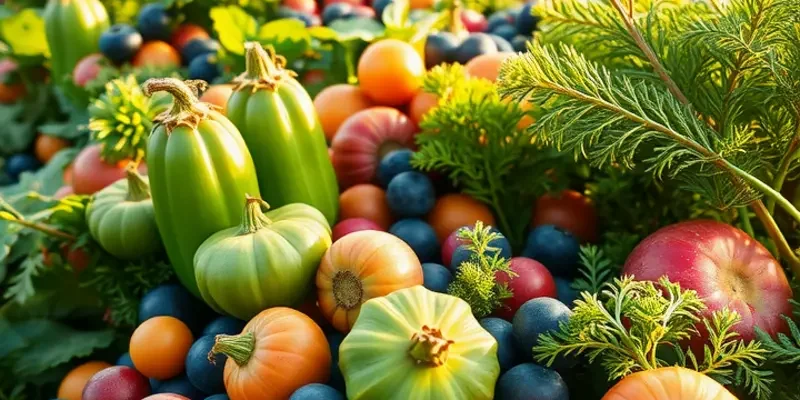Plant pigments are not just responsible for the colors of the fruits and vegetables we enjoy; they are also packed with health benefits that can significantly enhance our daily wellness. These natural compounds, often referred to as phytonutrients, contribute to various health-promoting properties—from antioxidant effects to anti-inflammatory actions. By integrating pigments-rich foods into our diet, we can thrive on a colorful plate that nurtures not only our bodies but our minds too.
The Vibrant Spectrum of Benefits

As nature’s palette, plant pigments offer a dazzling array of colors that symbolize more than just beauty. These pigments are powerful phytonutrients with unique health benefits, each identified by their distinctive hues. Let’s delve into how these colors can transform your diet into a rainbow of wellness.
First on this colorful journey are the anthocyanins, predominantly found in blue, red, and purple-colored foods such as blueberries, cherries, and purple cabbage. These pigments exhibit potent antioxidant properties, protecting the body from oxidative stress and inflammation. Regular consumption of anthocyanin-rich foods may support heart health, improve cognitive function, and help manage weight.
Next, the golden glow of carotenoids, present in carrots, sweet potatoes, and leafy greens, speaks to their beneficial impact on health. Not only do they contribute to the vibrant orange, yellow, and red hues, but they also play a crucial role in enhancing vision, supporting immune function, and providing antioxidant effects. Beta-carotene, a common carotenoid, is a precursor to vitamin A, essential for maintaining good vision and skin health. Ensuring these pigments are part of your meals can be as simple as adding roasted butternut squash soup or a fresh carrot salad to your menu.
The world of greens is dominated by chlorophyll, the pigment responsible for the rich green colors in kale, spinach, and broccoli. Chlorophyll is not just the backbone of photosynthesis; it also offers detoxifying and anti-inflammatory benefits. Its role in promoting healthy digestion and providing a natural energy boost makes it indispensable for daily nutrition. Incorporating chlorophyll-laden greens into smoothies or salads can improve your body’s balance and vitality.
Understanding how to integrate these pigments into our meals may seem daunting, but it’s simpler than it appears. Embrace these colors through mindful meal planning. For those looking for practical guidance on reducing waste and optimizing nutrient retention, consider exploring low-waste cooking techniques that revolve around vibrant plant-based dishes. You can learn more about these techniques here.
Each pigment contributes uniquely to the symphony of nutrients available from plants. Combined, they provide an array of benefits that enhance overall wellness. By actively choosing diverse colors in our diet, we embrace the natural power of food as medicine. This embrace not only supports personal health but also enriches our culinary experience by encouraging innovation and variety into our dietary habits.
Increasing the consumption of colorful fruits and vegetables can be the cornerstone of a nutritious lifestyle. Consider experimenting with new recipes that focus on these vibrant ingredients. Thus, the journey to better health is painted not in broad strokes but in the intricate details of these natural wonders.
Incorporating Pigments into Your Diet

Incorporating colorful plant pigments into your daily meals can be both delightful and nutritious. These pigments not only bring vibrancy to your plate but also offer a myriad of health benefits. Let’s explore some practical tips and easy recipes to get you started on embracing these natural hues.
A simple way to add color to your meals is by starting with fruits and vegetables. Aim to fill half your plate with these foods at every meal. For example, create a vibrant salad with leafy greens like spinach and kale, which are high in chlorophyll. Add red bell peppers, carrots, and purple cabbage to increase the pigment diversity.
For breakfast, consider a smoothie. Blend spinach, bananas, and a handful of berries for a nutritious and colorful start to your day. Berries are a rich source of anthocyanins, powerful antioxidants that have been linked to numerous health benefits. You can also experiment with other ingredients like chia seeds or a splash of plant-based milk to enhance the nutritional value.
When it comes to snacking, opt for fruits and vegetables that are easy to prepare and enjoy raw. Baby carrots, cucumber sticks, and mixed berries are all excellent choices. These require minimal preparation and are perfect for those looking to incorporate more raw foods, preserving the integrity of their beneficial pigments.
Main dishes offer further opportunities to integrate plant pigments. One easy idea is to cook a vegetable stir-fry with a variety of bell peppers, zucchini, and broccoli. Stir-frying is a quick cooking method that retains the vibrant colors and nutrients of the vegetables. If you’re looking for a more protein-rich option, add tofu or chickpeas to the mix.
In terms of preparation methods, some cooking techniques preserve pigments better than others. Steaming, for instance, helps retain the color and nutrients of vegetables more effectively than boiling. When making soups, try to minimize cooking time and refrain from overcooking your vegetables to preserve their color and nutritional content.
Proper storage is also crucial for maintaining nutrient levels. Consider exploring eco-smart kitchen storage methods to keep your fruits and vegetables fresh for longer. Learn more about sustainable kitchen practices here.
Finally, remember that the key is variety. Each pigment carries its own set of benefits, and a diverse palette ensures a more comprehensive intake of nutrients. Harnessing the power of plant pigments can transform meals into not only visually appealing plates but also powerful sources of nutrition. By following these tips, you can effortlessly incorporate these valuable pigments into your diet every day.
Final words
Understanding the role of plant pigments in our diet offers an exciting opportunity to enhance our health through colorful, nutrient-dense foods. From the antioxidant properties of anthocyanins in berries to the vision-supporting carotenoids in leafy greens, these natural pigments are fundamental to our overall well-being. Making simple changes to include a variety of these colorful foods can not only brighten your plate but also empower your health agenda. Make conscious choices to embrace the natural colors in your food, reaping the rewards of enhanced vitality and wellness.








